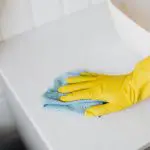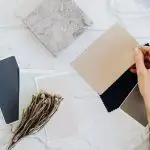When you use fabric glue in your projects, have you ever considered its environmental impact? Many popular adhesives contain harmful chemicals that can leach into soil and water, creating long-lasting damage to ecosystems and posing health risks to humans. As you work on your next crafting endeavor, think about the broader implications of these substances. What alternatives might be available, and how can you make more eco-conscious choices? The answers could reshape not just your crafting habits, but also your understanding of sustainability in everyday materials.
Table of Contents
Key Takeaways
- Fabric glue contains synthetic polymers and solvents that can leach harmful chemicals into soil and waterways if improperly disposed of.
- Volatile organic compounds (VOCs) in fabric glue contribute to air pollution and respiratory issues in humans and can harm aquatic life.
- Long-term accumulation of chemicals from fabric glue poses risks of environmental damage, affecting ecosystems and biodiversity.
- Prolonged exposure to fabric glue can cause health issues such as irritation, respiratory problems, and allergic reactions, particularly in vulnerable populations like children.
Composition of Fabric Glue
Fabric glue typically contains a blend of synthetic polymers, solvents, and additives that enhance its adhesive properties and performance. These polymers provide the primary bonding strength, allowing fabric pieces to stick together securely. When you apply fabric glue, you're mainly relying on these synthetic compounds to create a durable bond between fabrics.
The solvents in fabric glue help dissolve the polymers, ensuring a smooth application. Once the glue is exposed to air, these solvents evaporate, allowing the adhesive to set and form a solid bond. You'll often notice that the glue dries clear, making it ideal for various fabric types without leaving unsightly residue.
Additives play a crucial role too. They can improve the glue's flexibility, making it suitable for fabrics that stretch or move. Some formulations even incorporate anti-fungal or anti-bacterial properties, enhancing the longevity of your projects.
When choosing a fabric glue, consider these components, as they directly impact the effectiveness and durability of your final product. Understanding the composition helps you make informed decisions tailored to your specific crafting needs.
Environmental Hazards of Chemicals
Many chemicals found in fabric glue can pose significant environmental hazards, affecting both ecosystems and human health. When you dispose of fabric glue improperly, these harmful substances can leach into soil and waterways, disrupting local habitats. For instance, solvents like toluene and xylene can contaminate groundwater, posing risks to aquatic life and plants.
You should also be aware that volatile organic compounds (VOCs) emitted during the drying process contribute to air pollution. These chemicals can form ground-level ozone, which negatively impacts air quality and can harm wildlife.
Furthermore, if you're using fabric glue in large quantities, the risk of accumulation in the environment increases. This accumulation can lead to long-term damage, affecting biodiversity and the health of various species.
It's crucial to understand that even small amounts of these chemicals can have devastating effects. By choosing eco-friendly alternatives or properly disposing of fabric glue, you can mitigate these hazards. In doing so, you're not only protecting the environment but also contributing to a healthier ecosystem for future generations.
Impact on Human Health
Using fabric glue can expose you to harmful chemicals that may pose risks to your health, especially if proper ventilation isn't maintained during application. Many fabric glues contain volatile organic compounds (VOCs) that can evaporate into the air, leading to respiratory issues, headaches, and dizziness. If you're working in a closed space, the accumulation of these fumes can become more pronounced, making it crucial to ensure adequate airflow.
Moreover, prolonged skin contact with fabric glue can cause irritation or allergic reactions. If you notice redness, itching, or swelling, it's best to wash the area thoroughly and seek medical advice if symptoms persist. Children and pets are particularly vulnerable, as their smaller bodies can react more severely to toxins.
Ingesting fabric glue, whether accidentally or through improper storage, can lead to serious health complications. Always keep these adhesives out of reach and use them responsibly. Being aware of the potential health impacts helps you make informed decisions about your crafting materials and practices.
Sustainable Alternatives to Fabric Glue
Exploring safer crafting options can lead you to sustainable alternatives to traditional fabric glue that minimize health risks and environmental impact. One great choice is using natural adhesives like wheat paste or rice starch. These biodegradable options are made from simple ingredients and break down easily, reducing your ecological footprint.
You might also consider using double-sided tape or fabric tape, which are often more durable and can be reused. These tapes are easy to apply and remove, allowing for flexibility in your projects without the mess of liquid glue.
If you're looking for a glue that still offers a strong bond, opt for water-based adhesives. They contain fewer harmful chemicals compared to their solvent-based counterparts and are safer for both you and the environment.
Additionally, experimenting with sewing techniques can eliminate the need for glue altogether. Stitching can provide a stronger and more lasting bond, and it adds a unique touch to your creations.
Best Practices for Eco-Friendly Crafting
To create eco-friendly crafts, start by selecting materials that are sustainable and sourced responsibly. Look for organic fabrics, recycled papers, and non-toxic paints. These choices not only reduce your environmental impact but also promote healthier crafting conditions.
Next, consider the tools and adhesives you use. Opt for water-based glues or natural adhesives instead of traditional fabric glues that contain harmful chemicals. Always check labels for eco-friendly certifications to ensure you're making safe choices.
When it comes to your workspace, reduce waste by reusing scraps and leftover materials. Get creative with upcycling, turning old items into something new and beautiful. This practice minimizes landfill waste and inspires innovative designs.
Frequently Asked Questions
How Does Fabric Glue Affect Wildlife in Its Natural Habitat?
When you consider how fabric glue affects wildlife, think about the potential ingestion of toxic chemicals. These substances can disrupt animal health, harm ecosystems, and jeopardize the balance of natural habitats where species thrive.
Can Fabric Glue Be Recycled With Other Craft Materials?
You can't recycle fabric glue with other craft materials. Most glues aren't accepted in recycling programs due to their chemical composition. It's best to check local guidelines for proper disposal methods to minimize waste.
What Are the Long-Term Effects of Fabric Glue on Soil?
When you use fabric glue, its long-term effects on soil can include chemical leaching, which may alter soil pH and harm beneficial microorganisms. Over time, this can impact plant growth and overall soil health significantly.
Are There Biodegradable Options for Fabric Glue Available?
Yes, there are biodegradable options for fabric glue available. You can find brands that use natural ingredients, making them safer for the environment. Always check the label to ensure it meets your sustainability preferences.
How Do Different Brands of Fabric Glue Compare in Environmental Impact?
When you compare different fabric glue brands, consider their ingredients, production methods, and disposal options. Some may use safer materials, while others might release harmful chemicals. Always check labels for environmentally-friendly certifications.
- Tetron Fabric for Marine Applications: Durability and Use Cases - June 18, 2025
- Tetron Fabric for Outdoor Furniture: Weather Resistance and Care - June 18, 2025
- Tetron Fabric for Wall Coverings: Style and Application Tips - June 18, 2025





